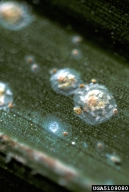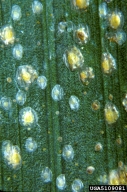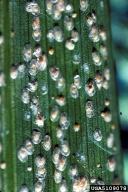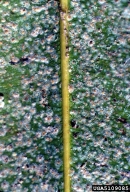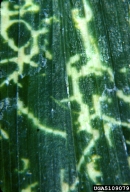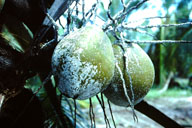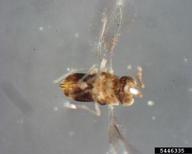Coconut scale
Aspidiotus destructor Signoret (Hemiptera: Diaspididae)
Orientation to pest
Coconut scale, Aspidiotus destructor Signoret, has an extremely broad host range, feeding on over 60 different families of plants. As a pest of coconut (Cocos nucifera L.), it normally feeds on the undersurfaces of fronds, but when infestations are very dense, even fruits may be infested. Palms may be killed by heavy infestations, but in most cases, predators suppress the scale to less destructive levels.
Hosts commonly attacked
Coconut scale is a common pest of coconut (C. nucifera) and banana (Musa), and also infests avocado (Persea americana Miller), bird of paradise (Strelitzia), breadfruit (Artocarpus altilis [Parkinson] Fosberg), cassava (Manihot esculenta Crantz), cotton (Gossypium), ginger (Zingiber officinale Roscoe), guava (Psidium), mango (Mangifera indica L.), mock orange (Philadelphus), mountain apple (Syzygium malaccense [L.] Merr. and L. M. Perry), oil palm (Elaeis), papaya (Carica papaya L.), pandanus (Pandanus), frangiapani (Plumeria), rubber trees (Hevea brasiliensis Müll. Arg.), sugarcane (Saccharum), and tea (Camellia sinensis [L.]Kuntze).
Distribution
At a world level, this scale is widely distributed in tropical areas, including Puerto Rico. The mainland U.S. distribution of this scale includes Florida, Georgia, North Carolina, and Virginia.
Images of coconut scale
| Figure 1. Several adults of coconut scale, Aspidiotus destructor, on a palm frond | Figure 2. Crawlers of coconut scale interspersed among large adults | Figure 3. Colonies of various density of coconut scale on palm fronds | |
| Figure 4. Discolored streaks in palm fronds are a sign of coconut scale damage | Figure 5. Coconuts heavily infested with coconut scale | Figure 6. Encarsia citrina is a polyphagous aphelinid that attacks many diaspidid scales, including coconut scale |
Important biological control agents related to this pest species
A great many natural enemies of coconut scale have been reported (see summary in Waterhouse and Norris, 1987). See also discussion in Frank and Foltz (1996) for specific natural enemies present in Florida and Puerto Rico (see articles below for URL). Among the most important of these are the ladybird beetle Cryptognatha nodiceps Marshall and the parasitoid Encarsia citrina (Crawford).
Web links for information on coconut scale
- Pest of the Month | Secretariat of the Pacific Community
Discusses biology and control of coconut scale with reference to islands of the Pacific - Fact Sheet from Crop Knowledge Master | EXTension ENTOmology and University of Hawaii-CTAHR IPM
- Agricultural Pests of the Pacific Page | Agricultural Development in American Pacific
- FHTET Bulletin | USDA Forest Service
Information regarding cocunut scale is on page 13 - Species Catalog on ScaleNet
Complete list of all recorded natural enemies, hosts, and distribution records; also an index to all publications on this species
Articles
- Waterhouse, D. F. and K. R. Norris. 1987. Biological Control: Pacific Prospects. ACIAR, Inkata Press, Melbourne, Australia, see pp. 62-71.
